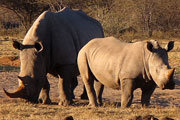African Parks buys the world’s largest white rhino collection to set them free in Africa
Almost everyone knows that rhinos are endangered. When 2,000 rhinos were put up for sale, representing about 15% of what’s left of the white rhino population, along with the farm Platinum Rhino, it became global news. In September 2023, African Parks purchased the farm, including the largest collection of rhinos in the world — and the good news is that they will be released into the wild.
 African rhino at watering hole
African rhino at watering hole
A businessman, white rhinos, and a conservation vision
The Platinum Rhino farm, where the rhinos currently are held in captivity, is located east of Johannesburg in South Africa. It was a project begun by businessman John Hume with 200 rhinos in 1992. Such was the success of the rhino breeding program that by 2023 the population had increased tenfold, and the running costs of the 8,000-hectare farm proved too much even for the former billionaire. He said he had exhausted his life savings on the philanthropic effort. The farm was put up for auction in April 2023 with a starting price of $10 million but failed to attract bids.
The biggest cost at Platinum Rhino was the surveillance on the farm to keep rhino horn poachers at bay. This required a team of about 100 rangers. White rhino horn retails for about US$ 60,000 (a million Rands) per kilo, and a white rhino horn weighs about 4kg, so it’s no wonder that poachers will risk life and limb to obtain it. Composed of keratin, the same material as your nails, the horn still sells for exorbitant amounts and is a status symbol in Asia, despite a lack of evidence for it having any real medicinal properties.
The problem of rhino poaching
Although poaching has been on the decline since 2015, more than 500 rhinos were still poached in Africa in 2022 and about 10,000 have been lost to poachers since 2007. Dehorning rhinos does deter poachers to some extent, but they are still often killed for the remaining stub of horn left upon their snouts. Most of the Platinum rhinos are dehorned, and Hume still hopes to sell his stockpile of horns to fund conservation projects. He has been arguing and lobbying for years that if you sell rhino horn legally, it will flood the market and drive down prices, which will slow or even halt poaching.
Most conservationists disagree, and say the only way to halt poaching is to lessen the demand for rhino horn in Asia. This is no easy task. Lynn Johnson writes that demand reduction campaigns are only effective if those who are buying rhino horns believe that there is a risk to their reputation or a risk to their health, and she stresses that they only work if the campaigns target those who are wealthy enough to afford it.
 Rhino population map by Save the Rhino
Rhino population map by Save the Rhino
White rhinos, once driven to near extinction, are today classified as “near threatened”, but with populations of less than 100 each, the Javan and Sumatran rhinos certainly are. There are about 6,487 black rhinos left and 4000 greater one-horned rhinos, so of the roughly 30,500 rhinos left on the planet, the white rhino population of about 16,000 is the largest group. “White rhinos” are southern white rhinos, most of which are in South Africa; sadly, there are only two northern white rhinos left, and, as they are both female, they will soon be extinct.
African Parks to the Rescue
African Parks is a conservation NGO that manages 22 protected areas, and a total of around 20 million hectares throughout Africa. With The Duke of Sussex, Prince Harry as the president, the charity boasts a superb track record of wildlife relocations, including moving rhinos and elephants.
With the successful purchase of the Platinum Rhino farm, over the next decade, African Parks aims to translocate the 2,000 white rhinos they have purchased to some of the protected areas they manage across Africa. This rewilding project will rank among one of the largest ever undertaken. Once safely relocated the rhinos have huge value for tourism, which supports local populations, and they also help to shape the ecology of the terrain in a big way. They are, after all, the second-largest mammals that walk the earth.
Moving rhinos
Moving the second largest land mammal is an extremely expensive process; the further the distance of the relocation, the higher the cost. It’s also risky: when six black rhinos were moved from South Africa to Chad in 2018, four of them died. Issues that will be monitored by teams of experts include diseases, different climates, the nutritional value of the plant life in the new location — and course, poaching.
Fortunately, in addition to their growing experience with moving species to new locations, African Parks have deep pockets, receiving funding of more than $500 000 per year from various funds, foundations and governments. South African conservationist Donovan Jooste says that they understand the risk and cost involved in moving the Platinum rhinos, but “2,000 rhinos in open systems is a lot better than 2,000 rhinos in a semi-captive operation”.
Saving a species
If this operation is done successfully, it will serve as a flagship for others. Rewilding restores the links that make up ecosystems, which effectively addresses climate change. By saving the rhino, we may help to save ourselves.
If you liked this post, these trips cover similar ground…
- 10 Day Zimbabwe & Kruger South Africa Lodge Safari
- 12 Day Kruger, Botswana & Victoria Falls Safari (Northbound)
- 4 Day Kruger Safari & Panorama Route Tour
- 4 Day Kruger National Park Safari - Tented Camping
- 3 Day Kruger National Park Safari - Tented Camping
- 12 Day Victoria Falls, Botswana & Kruger Safari (Southbound)
- 15 Day Namibia to Botswana & Kruger Camping Overland Tour
- 5 Day Panorama Route & Kruger Park Safari - South Africa






 Derek lives in Joburg, so any trips into the bush or along the coast border on being spiritual experiences. He is an author, editor, poet and a musician who enjoys cutting to the chase and discovering what lurks beneath the surface. Southern Africa has an endless wealth of hikes, trails and sights that keep him inspired.
Derek lives in Joburg, so any trips into the bush or along the coast border on being spiritual experiences. He is an author, editor, poet and a musician who enjoys cutting to the chase and discovering what lurks beneath the surface. Southern Africa has an endless wealth of hikes, trails and sights that keep him inspired.







